Secure Checkout + FREE SHIPPING (U.S. Orders over $60)
Menu
-
- Home
-
About Us
-
The Approach
-
Linking Language & Literacy
-
Professional Learning
-
Learning Resources
-
SHOP
-
Blog
-
- About MindWing
- Our People
- Contact Us
- Your Account
- Login
-
United States (USD $)

Secure Checkout + FREE SHIPPING (U.S. Orders over $60)
February is Black History Month — Lesson 3
by Sheila Zagula February 19, 2016 4 min read
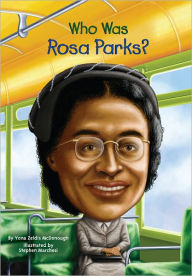 Having just read the biography Who Was Rosa Parks? written by Yona Zeldis McDonough, I gathered five of my favorite SGM Mini-Posters and sat down to create some lessons based upon this wonderful book for elementary school students. The blending of both narrative and expository text structures in this book makes it especially valuable to teach and reinforce the differences in text structures. It would make a wonderful informative read aloud as well as for use with individual student for reports and sharing. The Lexile measure is 700.
Having just read the biography Who Was Rosa Parks? written by Yona Zeldis McDonough, I gathered five of my favorite SGM Mini-Posters and sat down to create some lessons based upon this wonderful book for elementary school students. The blending of both narrative and expository text structures in this book makes it especially valuable to teach and reinforce the differences in text structures. It would make a wonderful informative read aloud as well as for use with individual student for reports and sharing. The Lexile measure is 700.
 The author includes two timelines, one showing Rosa Park’s life and the other corresponding to world events of the same years. This is especially helpful to relate to the setting of the biography. As we know, a setting includes not just the place but also the culture of the people of a specific time and area, as well as the historical events. Please refer to Lesson #2 of The Big Wave as it expands on the use of the Setting Map with novels and could be applied to this work as well.
The author includes two timelines, one showing Rosa Park’s life and the other corresponding to world events of the same years. This is especially helpful to relate to the setting of the biography. As we know, a setting includes not just the place but also the culture of the people of a specific time and area, as well as the historical events. Please refer to Lesson #2 of The Big Wave as it expands on the use of the Setting Map with novels and could be applied to this work as well.

Of course, what skills a teacher focuses on is decided by the children sitting in front of him/her, as well as learning objectives. Please feel free to expand on or change any of the ideas presented below to meet your students’ needs. If you decide to use this book as a read aloud, one idea would be to keep track of the chapters using the SGM Complete Episode Map and review the previous chapter each day before beginning a new one. This could be done on chart paper.
As I read this book, I felt it would lend itself especially well to Feelings and Character traits, so those were two of the mini-posters I readied. I also took out my SGM Marker, ThemeMaker and Critical Thinking Triangle Mini-Posters to help with my planning.
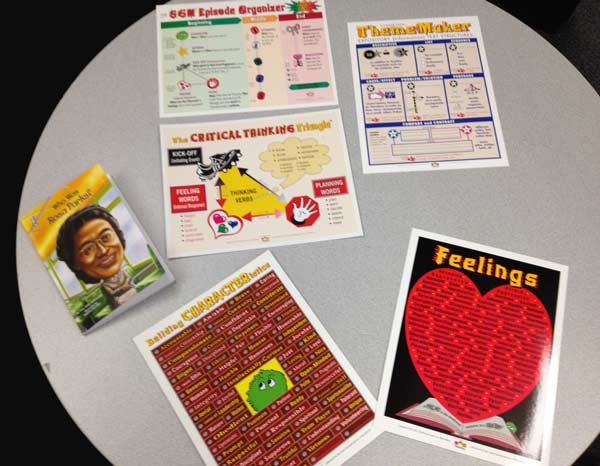 Below, please find some ideas for the first two chapters to get you started.
Below, please find some ideas for the first two chapters to get you started.
CHAPTER 1
![]() Rosa
Rosa
![]() Grandparents Farm / Pine Level, Alabama, 1915. The setting and time should be explored; in particular, the separate lives of black and white people.
Grandparents Farm / Pine Level, Alabama, 1915. The setting and time should be explored; in particular, the separate lives of black and white people.
NOTE: There is expository information presented on the Ku Klux Klan and Jim Crow Laws. These are integral parts of the setting creating multiple Kick-Offs throughout the book. Use a Descriptive Map and/or List Map to talk about these two influences on the time and place, and ultimately, on Rosa Parks. Other expository sections include: Brown vs. Board of Education, The Role of the Black Church, NAACP, Martin Luther King, Jr., as well as several others. Any one of these expository pieces could be explored in more detail with your students. I chose the Setting Descriptive Map from the ThemeMaker to present these to the students. It makes a good visual to discuss and explore the culture and time of this biography. You could add on to the map as the selection is read, as shown.
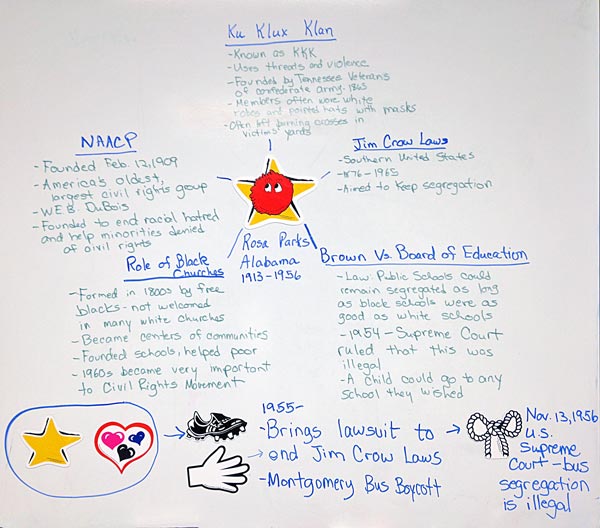
List Map
Ku Klux Klan:
- Known as KKK
- Uses threats and violence
- Founded by Tennessee veterans of the confederate army in 1865
- Members wore white robes and pointed hats with masks
- Often left burning crosses on victims’ yards
Jim Crow Laws:
- Southern United States
- 1876-1965
- Kept segregation
- Ex: Blacks could not eat at same restaurants, buy houses in white neighborhoods
![]() Parents separated in 1915 and Rosa and her mother and brother moved to grandparents farm in Pine Level, Alabama
Parents separated in 1915 and Rosa and her mother and brother moved to grandparents farm in Pine Level, Alabama
![]() safe on the farm (but outside of farm…)
safe on the farm (but outside of farm…)
![]() to enjoy life
to enjoy life
![]() went to and loved school
went to and loved school
![]() explored in woods
explored in woods
![]() enjoyed Pine Level, her family was free
enjoyed Pine Level, her family was free
CHAPTER 2
![]() Mother sends Rosa to live with relatives in Montgomery Alabama so she could go to a better school.
Mother sends Rosa to live with relatives in Montgomery Alabama so she could go to a better school.
![]() excited
excited
![]() To attend Montgomery Industrial School for Girls, which was run by white northerners.
To attend Montgomery Industrial School for Girls, which was run by white northerners.
![]() liked city feel...
liked city feel...
![]() ...found, however, it was like Pine Level.
...found, however, it was like Pine Level.
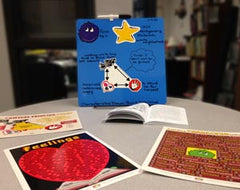 This point in the biography is an ideal place to use the Critical Thinking Triangle® and Feelings and Characteristic Mini-Posters. It is a good example of an incident that happened to Rosa when she was 11 years old, being around the same age as some of the students participating. It also serves to show how using evidence from the selection helps us to determine character traits.
This point in the biography is an ideal place to use the Critical Thinking Triangle® and Feelings and Characteristic Mini-Posters. It is a good example of an incident that happened to Rosa when she was 11 years old, being around the same age as some of the students participating. It also serves to show how using evidence from the selection helps us to determine character traits.
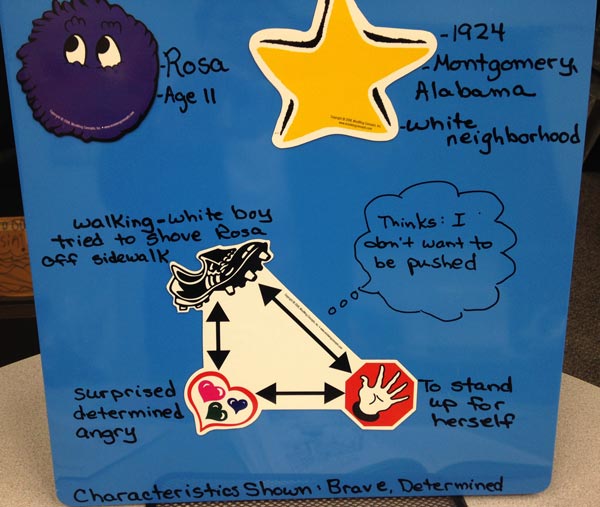
![]() spent 4 years at the school
spent 4 years at the school
![]() school was forced to close as it was twice set on fire; she attended an all black school wanting to become a teacher like her mother
school was forced to close as it was twice set on fire; she attended an all black school wanting to become a teacher like her mother
![]() Rosa’s grandmother got sick. Rosa returned to Pine Level, after dropping out of school at age 16, then her mother became ill.
Rosa’s grandmother got sick. Rosa returned to Pine Level, after dropping out of school at age 16, then her mother became ill.
![]() unhappy to leave school, but loving, helpful, willing (from Feelings Poster)
unhappy to leave school, but loving, helpful, willing (from Feelings Poster)
![]() to move back home and help family
to move back home and help family
![]() to make money: cleaned houses for white people
to make money: cleaned houses for white people
![]() sold fruit
sold fruit
![]() joined church
joined church
![]() learned to put faith in God; she also met Raymond Parks
learned to put faith in God; she also met Raymond Parks
![]() peaceful, interested, curious
peaceful, interested, curious
Expository Section: List Map
The role of black churches:
- Formed before 1800s by free blacks in Pennsylvania, Virginia and Georgia
- Began as blacks were not welcome in many white churches
- Churches became centers of communities
- Founded schools and helped poor
- 1960s churches became very important to civil rights
Hopefully, these ideas are helpful to you! There are many other selections in this “Who Was/Is…” series that you may be interested in checking out. We will present other books in this series at a later date.
Sheila Zagula
Sheila Zagula works with MindWing Concepts in product development, drawing on her expertise and talents as well as many years of implementing the Story Grammar Marker® and related materials. Her teaching career spans thirty-eight years, most recently as literacy coach in the Westfield Massachusetts Public School System. Sheila has experience as an early childhood educator, a teacher of children with special needs, and a collaborative instructor within an inclusion framework serving children in grades K-5.
Leave a comment.
Comments will be approved before showing up.
